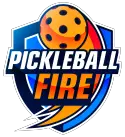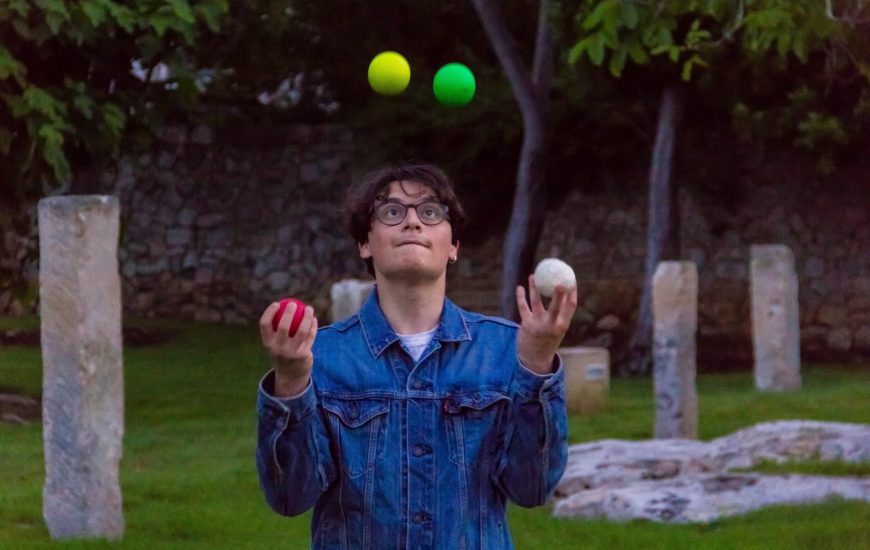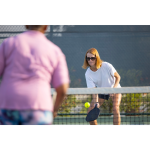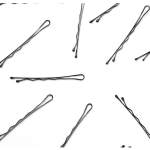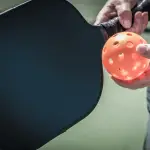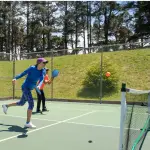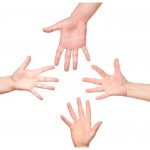Have you ever wondered why some people who are brand new to Pickleball are better than others who have played for years? Most likely they have played some other racket sport or at least some other sport using a ball such as soccer, basketball, hockey or football. So, what is the advantage of having played another ball sport? These players have excellent reaction time and eye-hand coordination which was developed through these activities.
There is no doubt having these two skills helps your Pickleball game too. But can you improve your eye-hand coordination and reaction time whether or not you played a ball sport in the past? The answer is a resounding Yes! In this article, I’ll discuss how to improve this aspect of your game. But, first let’s define what I mean by these two abilities.
Reaction Time in Pickleball and Other Sports
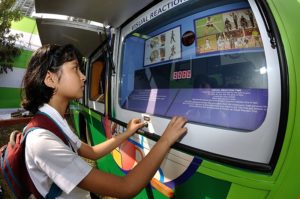
Reaction time is how long it takes for you to respond to a stimulus. What does this mean in Pickleball? The stimulus can be the ball, your opponent, or your opponents paddle. All of these things are cues for you to respond to when returning the ball. In an analysis of Pickleball, the speed of the ball when two players are standing at the non-volley zone is 30-40 miles per hour. That means you have about ¼ of a second to respond. Compare this to a baseball batter who is hitting a 90 mile per hour pitch. They need to respond in about a ½ of a second because the distance from the pitchers mound to home plate is 60 feet. So, Pickleball players need even faster reaction time than major league baseball players.
Eye-Hand Coordination
Eye-hand coordination is a bit more difficult to explain. The idea when you play Pickleball is that your eyes take in information to help guide your hands in making a movement like hitting the ball. It is a cognitive-spatial skill which can be improved with training.
Scientists believe there are two aspects of eye-hand coordination which are meaningful for athletes. First is how long a player is able to keep a steady gaze on the ball. Roger Federer is a tennis great who has exceptional focus on the ball when he hits it. He will often look at the point of contact long after the ball has left his racket.
The second type of eye-hand coordination is more predictive in nature. An athlete will compare the ball as it approaches to past experiences and know exactly where the ball is going. They don’t even need to look a the ball with a steady gaze to hit it. However, the combination of both types of eye-hand coordination maximizes performance.
How to Improve Reaction Time and Eye-Hand Coordination
Ball Toss and Bounce
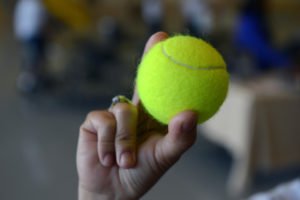
This is one of the most basic ways to improve eye-hand coordination. Toss a Pickleball or tennis ball against the wall and catch it. You should be just a few feet from the wall if you also want to work on reaction time. Start by catching the ball with two hands and then one hand. You can alternate which hand you catch and throw the ball with to make it more interesting.
I did a variation of this drill for countless hours when I was in grade school. My parents did not let me play organized sports until I was in junior high due to a health condition when I was a toddler. Of course, I loved sports so I spent thousands of hours bouncing a ball on a tennis racket. I would challenge myself with a new record each day so I could easily keep the ball going a couple of hundred times without missing. Little did I know then that this was great training to improve eye-hand coordination.
Juggling
Juggling was another sports related activity I did as a child. I never mastered more than three balls but I could juggle and keep the balls going for awhile. Once again, it was something I started doing for fun having no idea I was improving my reaction time and improving eye-hand coordination.
Video games and Phone Apps
I was never very interested in video games when I was young and still am not. However, my nephew spent thousands of hours playing video games in his youth and still does as an adult. I bet he isn’t really aware that these games are a great way to improve eye-hand coordination and reaction time. You may want to try it sometime or one of many apps you can download on your phone like Improve Your Reaction Time.
Reflex Volleys
Getting back to a drill specific to Pickleball and great for eye-hand coordination is the reflex volley. Stand a couple of feet from a wall with your paddle and ball. Hit the ball toward the wall at an easy pace to start. Then hit the ball hard at the wall so you have to react quickly to return it. The try to control the ball back to the wall. Alternate hitting hard shots at the wall followed by a softer shot. Make sure to hit both forehands and backhands and keep the shots going one after another.
Strong Gaze
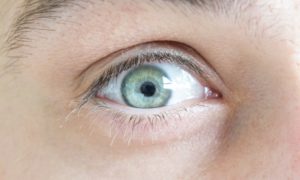
I played Pickleball at the YMCA yesterday and had a rough time to start. The team we were playing against was very good and I was making a lot of errors. When this happens, I remind myself to look at the ball all the way to the point of contact. This isn’t just when I am hitting the ball but also when my partner or opponent is. I find this helps the speed of my reactions as I am getting better visual cues.
Looking Close and Far Away
As I described above, I switch between looking at the ball contacting my paddle and watching the ball contact my opponent’s paddle. This is actually a good technique to improve eye-hand coordination. You can also practice this off the court even while sitting at your desk. I look closely at the details of my computer screen and then far away at the details of my neighbors house across the street. This simulates what I do in a Pickleball game and provides exercise for my eyes by changing the point of focus.
Strobe Glasses
Basketball great Stephen Curry uses Strobe glasses to help improve his eye-hand coordination. The glasses emulate strobe lights like what you might see at a disco of yesteryear. The lights serve as a distraction so it makes you focus on the most important visual cues. The strobe glasses are worn while Curry does dribbling drills so he can improve eye-hand coordination. Michael Jordan used a similar device which helped the game slow down for him. Strobe glasses are a controversial approach as flashing lights can cause a feeling of being off balance or dizziness. However, it works for Curry and did for Jordan also.
